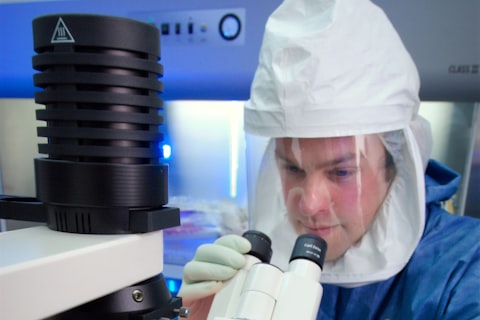Unraveling the Origins of Virology: A Journey Through the Study of Viruses
Unraveling the Origins of Virology: A Journey Through the Study of Viruses
Keywords
Virology Viruses Microscopy Vaccine Electron Microscopy Molecular Virology Public Health
Introduction to Virology
-
Virology is the scientific study of viruses.
-
Traces its history back centuries, evolving significantly over time.
-
Key milestones have shaped our understanding of viruses.
Early Observations of Viruses
- Ancient civilizations noted diseases with viral infection characteristics.
- Concept of viruses as distinct entities was not understood then.
Discovery of the First Virus
- Tobacco Mosaic Virus (TMV) discovered by Dmitri Ivanovsky in 1892.
- Demonstrated existence of infectious agents smaller than bacteria.
Development of Microscopy and Virology
- Electron microscope invention allowed detailed visualization of viruses.
- Led to discoveries in viral classification and characterization.
Contributions of Louis Pasteur
- Developed vaccines against rabies, contributing to immunology.
- His work laid the groundwork for preventing viral diseases through vaccination.
The Golden Age of Virology
- Mid-20th century saw rapid advancements and vaccine development.
- Identification of viruses like influenza, poliovirus, and HIV.
Emergence of Electron Microscopy
- 1930s electron microscopy innovation allowed nanoscale virus visualization.
- Facilitated virus classification based on morphology and genetics.
Identification of Viral Families
- Viruses classified into families by genetic material and replication strategies.
- Classification aids understanding of viral diversity and evolution.
Advancements in Molecular Virology
- Molecular biology techniques revolutionized virology in the late 20th century.
- Enabled study of viral genetics and replication at the molecular level.
Virology in the Modern Era
- Virology is crucial for public health and pandemic preparedness.
- Genomics and bioinformatics advancements aid in rapid virus identification.
Impact of Virology on Medicine
- Insights into prevention, diagnosis, and treatment of viral diseases.
- Vaccines have eradicated diseases like smallpox and reduced infection burdens.
Challenges and Future Directions
- Emerging diseases, antimicrobial resistance, and vaccine hesitancy are challenges.
- Future research focuses on novel therapies and global surveillance enhancements.
Ethical Considerations in Virology Research
- Ethical guidelines ensure responsible conduct of virology research.
- Addresses bioterrorism concerns and equitable vaccine distribution.
Conclusion
- Virology has evolved into a critical science for combating viral diseases.
- Continues to contribute to public health and infectious disease research.
Figures
Timeline of Virology:
-
Introduction to Virology
-
Early Observations of Viruses
-
Discovery of the First Virus
-
Development of Microscopy and Virology
-
Contributions of Louis Pasteur
-
The Golden Age of Virology
-
Emergence of Electron Microscopy
-
Identification of Viral Families
-
Advancements in Molecular Virology
-
Virology in the Modern Era
-
Impact of Virology on Medicine
-
Challenges and Future Directions
-
Ethical Considerations in Virology Research
-
Conclusion
Unraveling the Origins of Virology: A Journey Through the Study of Viruses
Virology, the branch of science dedicated to the study of viruses, has a rich history that dates back centuries. From early observations of microscopic entities to the modern era of molecular virology, the field has made significant strides in understanding these unique infectious agents. In this article, we will explore the origins of virology, tracing its evolution from ancient times to the present day and highlighting key milestones and contributions that have shaped our understanding of viruses.
Early Observations of Viruses
The history of virology can be traced back to ancient times when humans first observed the effects of viral infections. Early civilizations documented outbreaks of diseases that exhibited characteristics similar to what we now know as viral infections, although the concept of viruses as distinct entities was not yet understood.
Discovery of the First Virus
The first virus to be discovered was the Tobacco Mosaic Virus (TMV) in 1892 by Russian scientist Dmitri Ivanovsky. Ivanovsky's experiments with infected tobacco plants laid the foundation for the field of virology by demonstrating that an infectious agent smaller than bacteria was responsible for the disease.
Development of Microscopy and Virology
The invention of the electron microscope in the 20th century revolutionized the field of virology by allowing scientists to visualize viruses for the first time. This technological advancement enabled researchers to study the structure and morphology of viruses in detail, leading to significant discoveries in viral classification and characterization.
Contributions of Louis Pasteur
Louis Pasteur, a pioneer in the field of microbiology, made significant contributions to virology through his work on rabies and other viral diseases. Pasteur's development of vaccines against rabies and other viral infections laid the groundwork for the field of immunology and the prevention of viral diseases through vaccination.
The Golden Age of Virology
The mid-20th century marked the "Golden Age" of virology, characterized by rapid advancements in the study of viruses. During this period, researchers identified and characterized numerous viruses, including the influenza virus, poliovirus, and HIV, leading to breakthroughs in vaccine development and antiviral therapies.
Emergence of Electron Microscopy
The development of electron microscopy in the 1930s provided virologists with a powerful tool for visualizing viruses at the nanoscale level. This technological innovation allowed researchers to study the intricate structure of viruses and paved the way for the classification of viruses into different families based on their morphology and genetic makeup.
Identification of Viral Families
Through decades of research, virologists have identified and classified viruses into distinct families based on their genetic material, replication strategies, and host range. This classification system has helped researchers understand the diversity of viruses and their evolutionary relationships, providing insights into viral pathogenesis and transmission.
Advancements in Molecular Virology
The advent of molecular biology techniques in the latter half of the 20th century revolutionized the field of virology by enabling researchers to study the genetic makeup and replication mechanisms of viruses at the molecular level. This molecular approach has led to a deeper understanding of viral pathogenesis, host-virus interactions, and the development of antiviral drugs.
Virology in the Modern Era
In the modern era, virology continues to play a crucial role in public health, infectious disease surveillance, and pandemic preparedness. Advances in genomics, bioinformatics, and structural biology have enhanced our ability to rapidly identify and characterize new viruses, such as the SARS-CoV-2 virus responsible for the COVID-19 pandemic.
Impact of Virology on Medicine
The field of virology has had a profound impact on medicine by providing insights into the prevention, diagnosis, and treatment of viral diseases. Vaccines developed through virology research have eradicated deadly diseases such as smallpox and significantly reduced the burden of other viral infections worldwide.
Challenges and Future Directions
Despite the progress made in virology, challenges such as emerging viral diseases, antimicrobial resistance, and vaccine hesitancy continue to pose threats to global health. Future directions in virology research include developing novel antiviral therapies, improving vaccine technologies, and enhancing global surveillance systems to detect and respond to viral outbreaks.
Ethical Considerations in Virology Research
As virology research advances, ethical considerations surrounding the use of viruses in research, bioterrorism concerns, and the equitable distribution of vaccines become increasingly important. Ethical guidelines and regulations are essential to ensure that virology research is conducted responsibly and benefits society as a whole.
Conclusion
In conclusion, the field of virology has come a long way since its humble beginnings, evolving into a multidisciplinary science that plays a critical role in understanding and combating viral diseases. From the discovery of the first virus to the development of vaccines and antiviral therapies, virology has made significant contributions to public health and continues to be at the forefront of infectious disease research. By building on past achievements and embracing new technologies, virologists are poised to address the challenges of the future and protect global health from the threat of viral infections.




تعليقات
إرسال تعليق